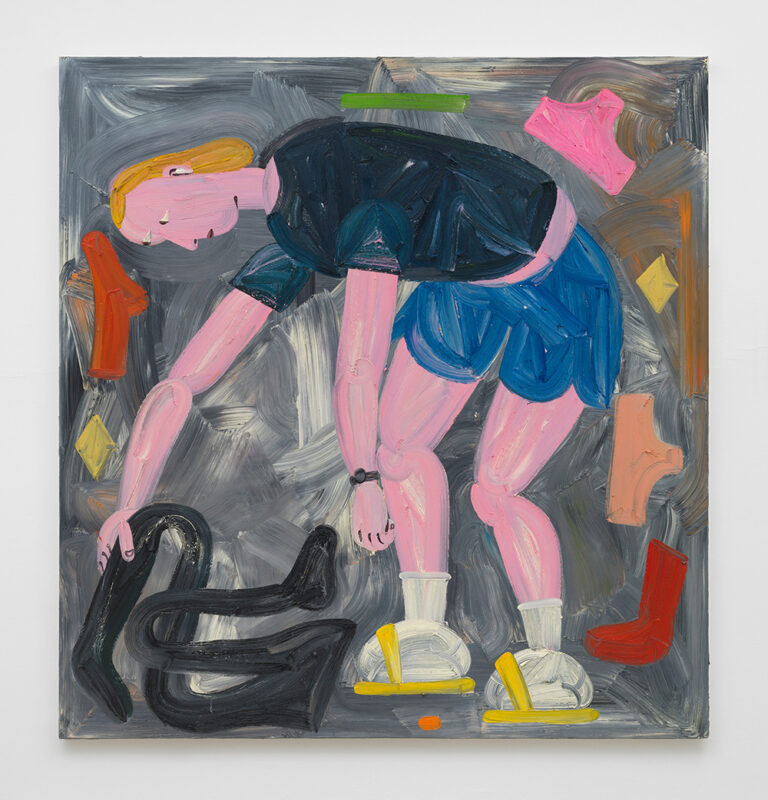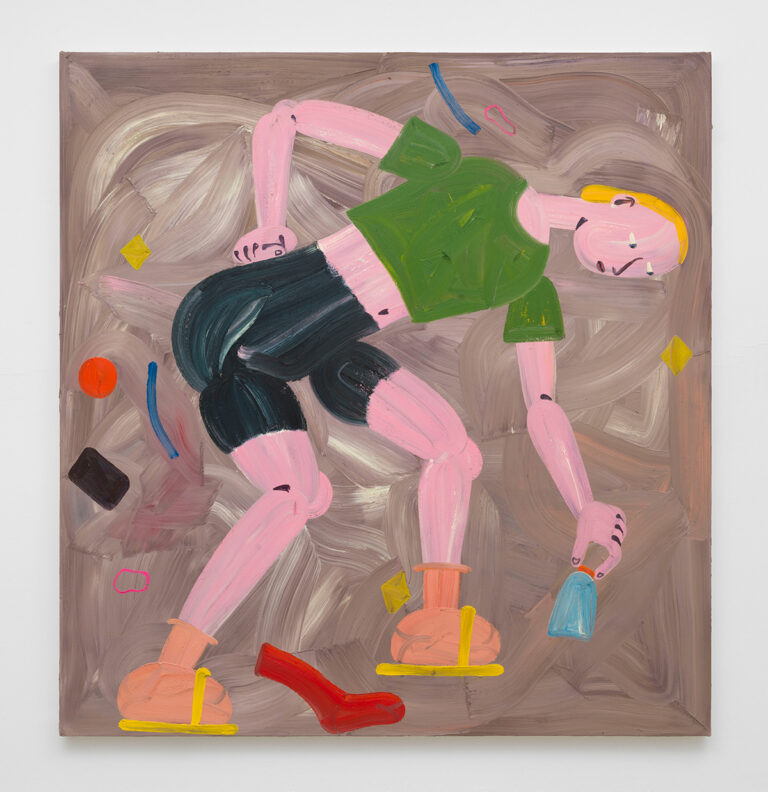Grace Weaver
Laundry
Gallery Openings—15 Sep 2023, 6 to 9 PM
Tomorrow’s Monday maybe we’ll do some laundry
Clean clothes for one night in New York
I’ve got to hardboil some eggs for lunch on Tuesday
Pack a complete bag and stay healthy
Bernadette Mayer
In her fourth solo exhibition at Soy Capitán—Laundry—Grace Weaver presents a series of new paintings that continue her interest in painting’s potential to capture the strange poetics of the everyday. Similar to the Language poetry of Bernadette Mayer, in which nothing is too trivial for the honor of inclusion, Weaver’s visual “enchanted mundanity” represents the tedium of daily routines through acts of repetition, variation and visual description, thereby creating a state of hyperattention on the unmonumental moments of everyday life.
The paintings often begin with a quotidian object, activity or interaction and usually depict a variant or model of the modern woman who isn’t necessarily Weaver herself, but perhaps reflects, as Weaver says, surrogates of surrogates of surrogates of herself, as she walks, runs, runs errands, shops, chats or cleans. If the woman in the image is a modified and alienated version of the artist, the painting’s seemingly trivial themes—in this exhibition, laundry—undergo a similar estrangement: dirty laundry and other homely items lie as abstract blobs of color or simple geometric forms on the surface of the painting, devoid of detail and depth, as if the reality of time and space stopped right in this hyperreal moment of humdrum housework. Through their warped perspectives and theatrical compositions, Weaver’s paintings transform and compress the unspectacular moment of daily life into specters of strange familiarity. As the poet Lyn Hejinian writes: “The quotidian consists not of things but of effects playing over the surfaces of things; it is not beings but a way of being.”
Similar to the the disjunction of the signifier in much of Language poetry, Weaver’s paintings violate the referential order of figurative painting. As they evade an undistorted representation of reality, they arrive at a form that condenses and displaces that reality. Simple shapes in obscure colors suffice to be recognizable as panties, iPhones or Doritos. Bodies are implied only by loosely connected limbs, evoked by rough and quick brushstrokes. Perhaps Weaver’s paintings feel akin to poetry because these simplified gestures remind more of the abstractions of writing than the representations of figurative painting. But unlike the writing page, the painting’s surface leaves no space for corrections. Painting wet-in-wet with over-sized brushes, Weaver adds oil color on a dark and damp background and as she works into it with both pale and bright colors, the greys and blacks stain and seep into every brushstroke, whereby every tiny movement of the brush, and hence, every thought and mistake are inevitably registered. But even if the colors are impure and the figures simple, Weaver’s practice is far form the deskilling discourse and much closer to Beckett’s fail-better. As she pushes further towards failure, contingency and clumsiness, Weaver’s paintings account for the “fleshy, funny, downward-facing, uncontrollable” awkwardness of daily affects and movements.
In Weaver’s paintings, everything is slightly larger-than-life and ill-fitting. The figures appear superficial and comically flat, their limbs line up clumsily as they form what Amy Sillman has called “this laughable casement that is the body.” These body casements are cased in another case, that is, the painting’s frame. As the bodies bend over to pick up the laundry from the floor, it seems as if they’re squeezing into the shallow pictorial space to fit the tight edges of the canvas. The domestic space becomes a Beckettian closed space fiction, inhabited by characters ready to perform the everyday claustrophobic tragicomedy of a body feeling out of joint.

Grace Weaver, Floor-painting, 2023, Courtesy the artist and Soy Capitán, Berlin, Photo: Roman Maerz
Naturally, the laundry subject recalls Impressionist paintings such as Berthe Morisot’s “Woman Hanging the Washing” (1881)—“a close-up view where the rectangularity of the linens seems wittily to reiterate the shape and texture of the canvas, the laundress to suggest the work of the woman artist herself”—or Gustave Caillebotte’s “Linen to Dry” (1888) which omits the depiction of laundresses and instead focuses on the linen itself, fluttering in the wind like a weightless cloud. The postures of Weaver’s stooped figures, however, rather evoke the bent backs of Jean-Francois Millet’s “The Gleaners” (1857), Max Liebermann’s “Woman Gathering Potatoes” (1874), and probably most of all Georg Baselitz’s double-upside-down “Gleaner” (1979).
In combining Beckett’s claustrophobic tightness of space and Baselitz’s inverted worlds with auto-fictional experiences of what Griselda Pollock has termed “spaces of femininity,” Weaver explores the ‘universal antithesis’ between the perceiving subject and the perceived world. This gap between our subjective access to the sensations and relations of bodies and objects in a lived world and the objective reality of things can only be pictured through what Weaver has called, in following Emily Dickinson, “a slant-wise approach to the truth.” Weaver’s paintings, then, are slanted fictions of a day in the life, or as Bernadette Mayer writes in Memory: “It’s impossible to put things exactly as they happened or in their real order one by one but something happened that day in the middle of seeing some people & talking about some, something happened that day…”
Text by Sophia Rohwetter
“These are the habits of daily life—trash going out, groceries being picked up, errands being run. These are moments in which nothing dramatic is happening, at first glance. Moments which usually fade from our memories as time passes, whereas the seemingly significant parts of life float to the surface. I am trying to look closely at moments, objects, places and interactions that seem unimportant to us because they appear so unmonumental.”
Grace Weaver




